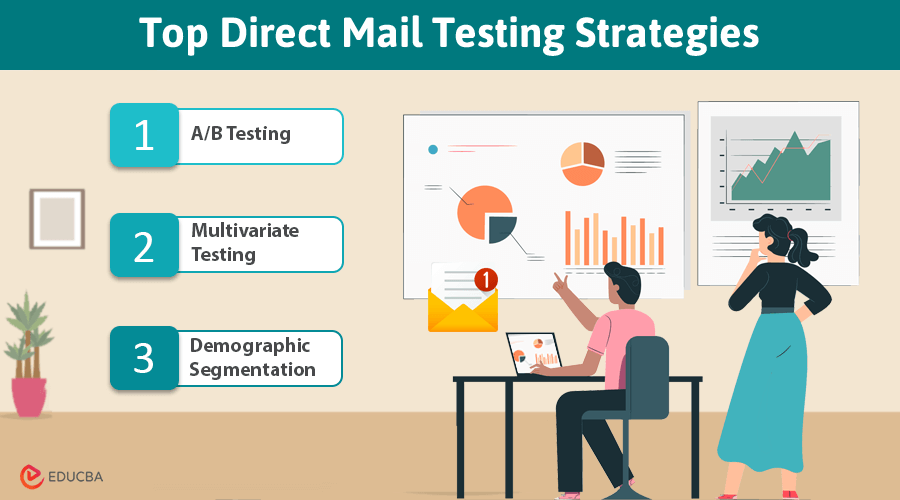
Introduction to Direct Mail Testing Strategies
Direct mail marketing is an effective tool, but success hinges on one critical factor: testing. Every element of your mailer, from design and messaging to audience targeting and offers, can influence your campaign’s performance. Mastering direct mail testing strategies is essential to maximizing your response and conversion rates.
This guide will help you optimize direct mail campaigns using A/B testing, segmentation, and multivariate testing. Learn how to set up control groups, analyze results, and improve performance for maximum impact.
Why Is Direct Mail Testing Important?
Testing is not just about small tweaks—it is about understanding your audience’s preferences and behaviors to deliver mailers that resonate and drive action. Here is why testing matters:
1. Enhances Response Rates
Testing helps you figure out what grabs your audience’s attention. Whether it is the design, the message, or the offer, testing allows you to discover the most effective ways to engage your recipients and encourage them to respond.
2. Boosts Conversions
By testing different elements like your offers, calls to action, and design, you can refine your approach to motivating recipients to take the next step. Whether making a purchase, signing up for a service, or clicking a link, testing helps you find the right combination to increase conversions.
3. Maximizes ROI
Testing helps eliminate guesswork, allowing you to focus on strategies that are proven to work. By understanding what appeals to your audience and improving your campaigns, you can achieve the best return on investment from direct mail efforts.
Top Direct Mail Testing Strategies to Try
Implementing effective direct mail testing strategies helps you explore different variables, gather insights, and fine-tune your campaigns for success. Here are some of the best approaches:
1. A/B Testing: The Foundation of Effective Testing
A/B testing means creating two versions of your mailer (Version A and Version B), where only one key element is different, such as:
- Headlines
- Images
- Offers
- Calls-to-action
How It Works:
Share each version with a portion of your audience and compare the results to determine which works best. Use these insights to optimize future campaigns.
2. Multivariate Testing: A Comprehensive Approach
Unlike A/B testing, multivariate testing evaluates multiple elements of your mailer simultaneously.
- Layout design
- Colors and fonts
- Offer placement
Why It Works:
This method helps uncover how different elements interact and which combinations yield the best results.
3. Demographic Segmentation: Target the Right Audience
Organize your mailing list by age, income, location, or interests. This ensures your message aligns with each group’s specific needs and preferences.
Benefits:
- Personalizes your approach
- Increases relevance and engagement
- Enhances response rates
Creative Direct Mail Testing Ideas
Fresh ideas can elevate your campaigns. Try these best direct mail testing ideas:
1. Experiment with Different Formats
Explore various mailer formats, such as:
- Postcards
- Fold-out brochures
- Catalogs
- Interactive mailers with embedded QR codes
2. Test Varied Offers
Your offer is often the deciding factor for recipients. Experiment with:
- Percentage discounts vs. dollar discounts
- Free trials
- Exclusive content
3. Adjust the Timing of Your Campaigns
Timing can significantly impact success. Test different:
- Days of the week
- Times of the month
- Seasonal themes
Starting with a Control Group
Using a control group is essential for successful testing in direct mail marketing. It lays the groundwork for comparing and analyzing your campaign’s performance.
The control group should be a random sample from your target audience mailing list. This ensures you can test specific factors while keeping the data accurate and results reliable.
Analyzing the Results of Your Tests
Testing is only effective if you take the time to analyze the results properly. Here is a breakdown of key metrics you should focus on:
1. Response Rates
This metric measures how many recipients take action after receiving your mailer. Actions could include visiting your website, calling for more information, or redeeming an offer. A higher response rate indicates that your message is resonating with the audience and compelling them to engage.
2. Conversion Rates
Conversion rates track how many recipients take the desired action, like purchasing, signing up for a service, or completing a form. This is the ultimate measure of your campaign’s success, reflecting how well your mailer drives business outcomes.
3. Use Analytics Tools
Use analytics tools to explore the data in detail to get the best results from your tests. These tools help you spot trends, like which version of your mailer performed best, and identify effective elements such as headlines, offers, or calls-to-action. Use these insights to improve your future campaigns and keep boosting your results.
Final Thoughts
Mastering direct mail testing strategies is key to running a successful campaign. You can continuously improve your approach by focusing on segmentation, experimenting with formats, and testing different offers. While it might initially seem challenging, the results of a well-tested direct mail program are worth the effort.
Ready to elevate your direct mail campaigns? Let Cactus Mailing help you test, refine, and achieve success with impactful direct mail strategies!
Recommended Articles
We hope this article on direct mail testing strategies has been helpful. Check out these recommended articles for more tips on optimizing your marketing campaigns and boosting your results.

